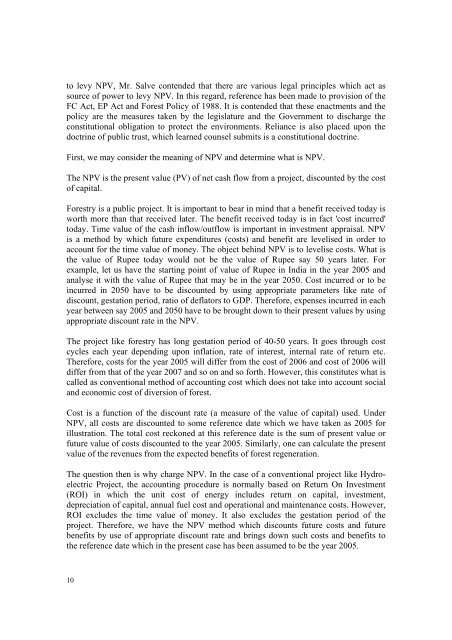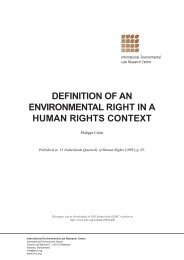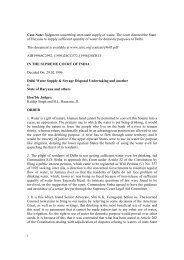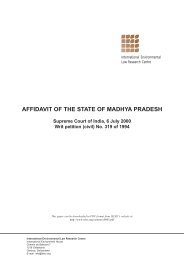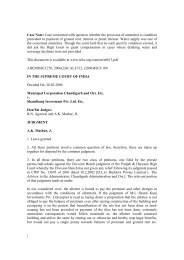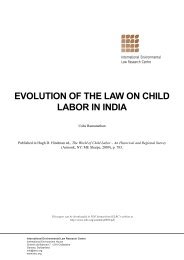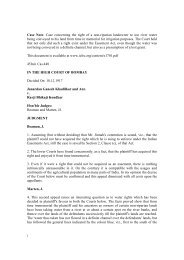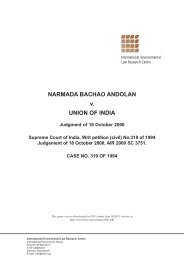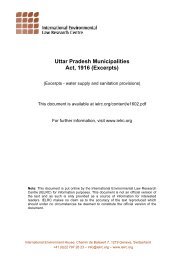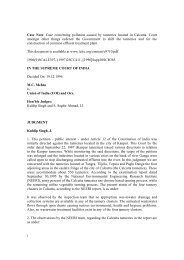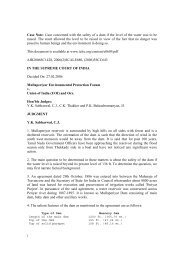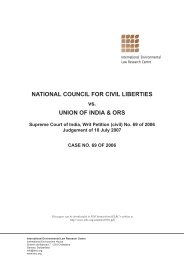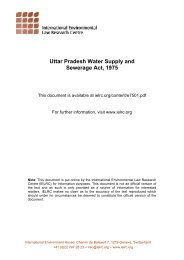T.N. Godavarman Thirumulpad v. Union of India - International ...
T.N. Godavarman Thirumulpad v. Union of India - International ...
T.N. Godavarman Thirumulpad v. Union of India - International ...
Create successful ePaper yourself
Turn your PDF publications into a flip-book with our unique Google optimized e-Paper software.
to levy NPV, Mr. Salve contended that there are various legal principles which act assource <strong>of</strong> power to levy NPV. In this regard, reference has been made to provision <strong>of</strong> theFC Act, EP Act and Forest Policy <strong>of</strong> 1988. It is contended that these enactments and thepolicy are the measures taken by the legislature and the Government to discharge theconstitutional obligation to protect the environments. Reliance is also placed upon thedoctrine <strong>of</strong> public trust, which learned counsel submits is a constitutional doctrine.First, we may consider the meaning <strong>of</strong> NPV and determine what is NPV.The NPV is the present value (PV) <strong>of</strong> net cash flow from a project, discounted by the cost<strong>of</strong> capital.Forestry is a public project. It is important to bear in mind that a benefit received today isworth more than that received later. The benefit received today is in fact 'cost incurred'today. Time value <strong>of</strong> the cash inflow/outflow is important in investment appraisal. NPVis a method by which future expenditures (costs) and benefit are levelised in order toaccount for the time value <strong>of</strong> money. The object behind NPV is to levelise costs. What isthe value <strong>of</strong> Rupee today would not be the value <strong>of</strong> Rupee say 50 years later. Forexample, let us have the starting point <strong>of</strong> value <strong>of</strong> Rupee in <strong>India</strong> in the year 2005 andanalyse it with the value <strong>of</strong> Rupee that may be in the year 2050. Cost incurred or to beincurred in 2050 have to be discounted by using appropriate parameters like rate <strong>of</strong>discount, gestation period, ratio <strong>of</strong> deflators to GDP. Therefore, expenses incurred in eachyear between say 2005 and 2050 have to be brought down to their present values by usingappropriate discount rate in the NPV.The project like forestry has long gestation period <strong>of</strong> 40-50 years. It goes through costcycles each year depending upon inflation, rate <strong>of</strong> interest, internal rate <strong>of</strong> return etc.Therefore, costs for the year 2005 will differ from the cost <strong>of</strong> 2006 and cost <strong>of</strong> 2006 willdiffer from that <strong>of</strong> the year 2007 and so on and so forth. However, this constitutes what iscalled as conventional method <strong>of</strong> accounting cost which does not take into account socialand economic cost <strong>of</strong> diversion <strong>of</strong> forest.Cost is a function <strong>of</strong> the discount rate (a measure <strong>of</strong> the value <strong>of</strong> capital) used. UnderNPV, all costs are discounted to some reference date which we have taken as 2005 forillustration. The total cost reckoned at this reference date is the sum <strong>of</strong> present value orfuture value <strong>of</strong> costs discounted to the year 2005. Similarly, one can calculate the presentvalue <strong>of</strong> the revenues from the expected benefits <strong>of</strong> forest regeneration.The question then is why charge NPV. In the case <strong>of</strong> a conventional project like HydroelectricProject, the accounting procedure is normally based on Return On Investment(ROI) in which the unit cost <strong>of</strong> energy includes return on capital, investment,depreciation <strong>of</strong> capital, annual fuel cost and operational and maintenance costs. However,ROI excludes the time value <strong>of</strong> money. It also excludes the gestation period <strong>of</strong> theproject. Therefore, we have the NPV method which discounts future costs and futurebenefits by use <strong>of</strong> appropriate discount rate and brings down such costs and benefits tothe reference date which in the present case has been assumed to be the year 2005.10


